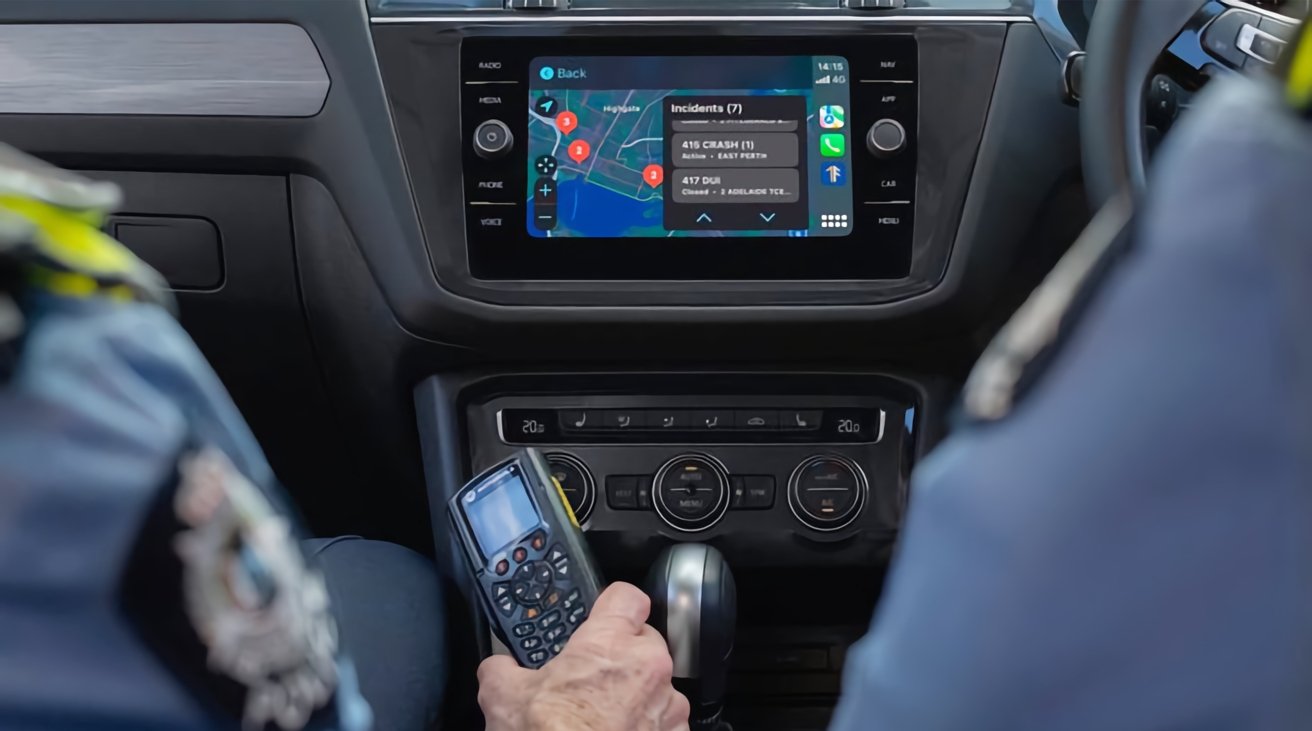Western Australia Police can now use CarPlay to respond to emergencies
Apple's CarPlay is being used for an unusual purpose, with Motorola Solutions and Western Australia Police creating an app for law enforcement that takes advantage of the in-vehicle display.

CarPlay is typically used by apps for audio playback management and displaying a map for navigation, among other uses, but not usually for work-related tasks. In a new mobile application produced between Motorola Solutions and the WA Police, Apple's in-car platform is being used to help police officers do their jobs.
OneForce Core is based on Motorola Solutions' PSCore public safety mobile application, an app for task management intended for essential services such as the police. Announced by Motorola on Friday, the CarPlay integration of OneForce Core cuts down on the need for an officer to look at an iPhone or iPad while in a vehicle.
Instead, the app displays essential information that an officer may need while driving in the car's built-in display, such as locations of incidents that they may need to attend. By using CarPlay, the app provides enough details to the officer while they are driving, without overwhelming them with other distracting information, and without needing any extra equipment.
While behind the wheel, officers can still interact with the app via CarPlay, by touching the screen or by taking advantage of verbal commands via Siri.
PSCore is already being used to help the WA Police move to digitally managing traffic infringement notices, with the CarPlay addition extending the app to further assist the more than 5,000 frontline officers.
"When police officers respond to an incident they need accurate and relevant information to inform their decisions and keep themselves and community members safe," said WA Police Deputy Commissioner Col Blanch. "Since deploying OneForce Core, our officers have been better informed with access to critical information wherever they are."
Read on AppleInsider

CarPlay is typically used by apps for audio playback management and displaying a map for navigation, among other uses, but not usually for work-related tasks. In a new mobile application produced between Motorola Solutions and the WA Police, Apple's in-car platform is being used to help police officers do their jobs.
OneForce Core is based on Motorola Solutions' PSCore public safety mobile application, an app for task management intended for essential services such as the police. Announced by Motorola on Friday, the CarPlay integration of OneForce Core cuts down on the need for an officer to look at an iPhone or iPad while in a vehicle.
Instead, the app displays essential information that an officer may need while driving in the car's built-in display, such as locations of incidents that they may need to attend. By using CarPlay, the app provides enough details to the officer while they are driving, without overwhelming them with other distracting information, and without needing any extra equipment.
While behind the wheel, officers can still interact with the app via CarPlay, by touching the screen or by taking advantage of verbal commands via Siri.
PSCore is already being used to help the WA Police move to digitally managing traffic infringement notices, with the CarPlay addition extending the app to further assist the more than 5,000 frontline officers.
"When police officers respond to an incident they need accurate and relevant information to inform their decisions and keep themselves and community members safe," said WA Police Deputy Commissioner Col Blanch. "Since deploying OneForce Core, our officers have been better informed with access to critical information wherever they are."
Read on AppleInsider

Comments
If you want an example of how use of commercial comms can go wrong, look at the Russian army in Ukraine.
It's innovative on the part of the WAP, and maybe other law enforcement agencies have done this, but at large? Hardly. I suspect an analysis of law enforcement world wide would find very few agencies with CarPlay in their enforcement vehicles. Every year more vehicles include CarPlay in their package options, some may even make it standard equipment. But most police agencies don't have the budget for that.
anyway, several police services in Australia are apple shops, carrying iPad minis as part of their belt gear and all using iPhones.
But what it really showed, in hindsight, is that the systemic process is one of inadequate planning where the end users have to go to heroic lengths to overcome the bureaucratic inefficiency that seems to infest large organisations. I had assumed that the project had continued to grow, but what little I can find online now suggests that it hasn't expanded beyond its initial deployment area.
With an extra few decades of software development under my belt, I'm not really surprised, but like TheObannonFile I recognise that my assumptions about that sort of stuff have been way too optimistic. Sigh.
It'd be nice (and safer?) to have a simpler, cleaner selection of "car-safe" apps and easy-to-press icons for Siri to do what it does on a CarPlay head unit.